The Noblot collection
The photographic collection of Adrien and Delphine Noblot was gathered in the 1920s and 1930s, at the height of the colonial period in French Indochina, when Adrien Noblot was a gendarme. In 2020, their family entrusted this photographic collection of more than 1,250 images to the InVisu UAR 3103 CNRS/INHA laboratory for study and availability to researchers.
The photographs in the collection construct a narrative showing the life of a French couple in colonial Indochina. They reflect the life of the Noblot family, their social life and their leisure activities. They also bear witness to colonial violence, whether through the presentation of Adrien Noblot's work as a gendarme, or through the perception and presentation of the indigenous and non-European populations of this region.
The database presents all the photographs in this collection as well as their captions for scientific purposes. Many of these items may offend the sensibilities of the public, who are invited to view them with all due caution.
Presentation of the collection
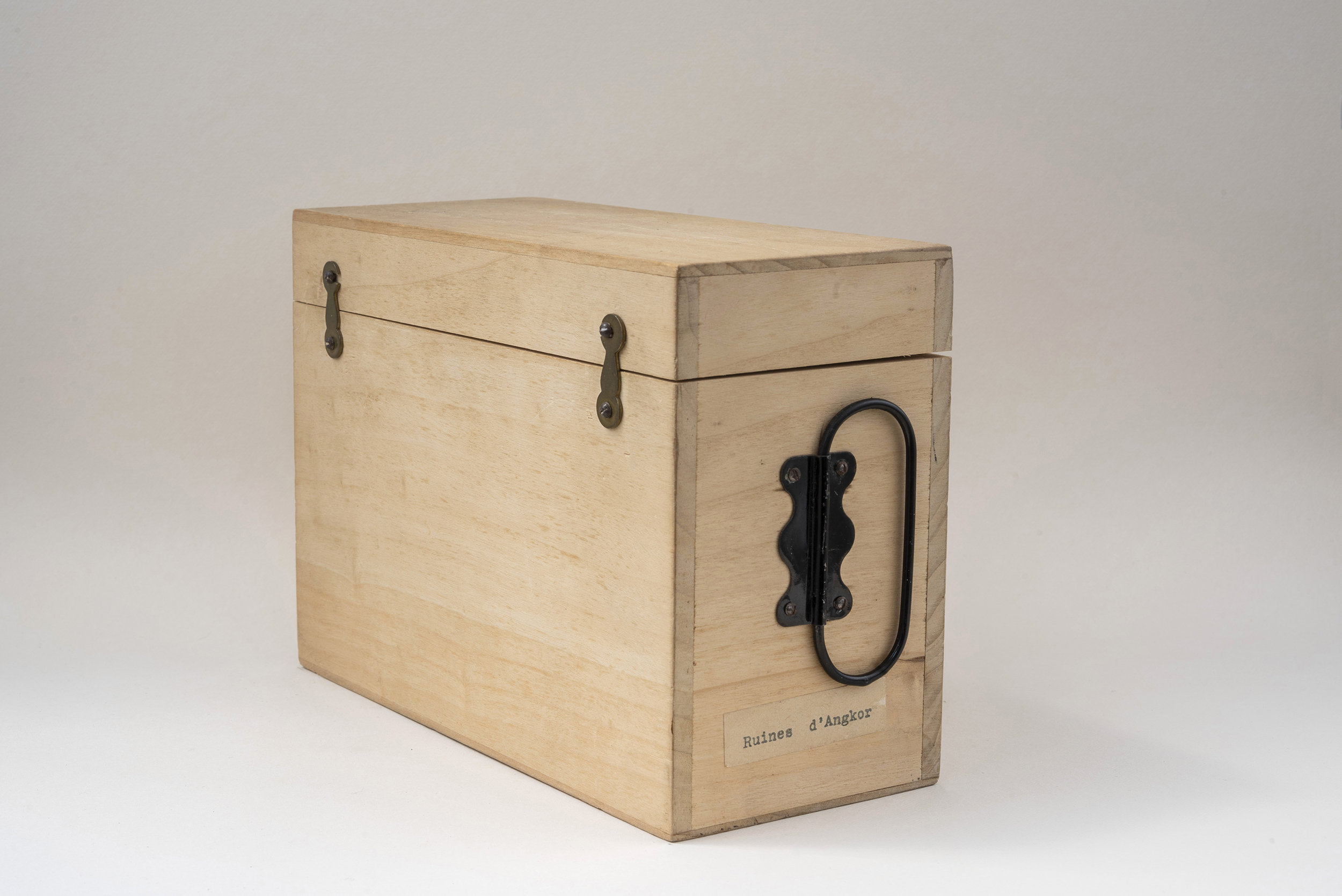
The collection consists of around 1250 photographs arranged in three albums, an typed report illustrated with photographs and stereoscopic views on glass plates kept in boxes. It does not include any negatives.
All the prints were made using silver bromide. The stereoscopic views were printed on glass plates, with the exception of one view on cellulose nitrate. Among the prints on paper, 59 photos are postcards. The paper prints bear the signatures and marks of 29 photographers. Around 450 photographs (prints and glass plates) have captions, or are accompanied by captions in the case of the report. Finally, the identified shooting locations are recorded as precisely as possible with the city, written by its French name (or even the name used in colonial times) and its current Vietnamese name.
The collection did not contain any archives that would allow for a better understanding of the history of its creation, and the family story passed on to the heirs of Adrien and Delphine Noblot did not always make it possible to identify all the photographs presented here. This introduction presents the current state of understanding of the collection.
The Albums :
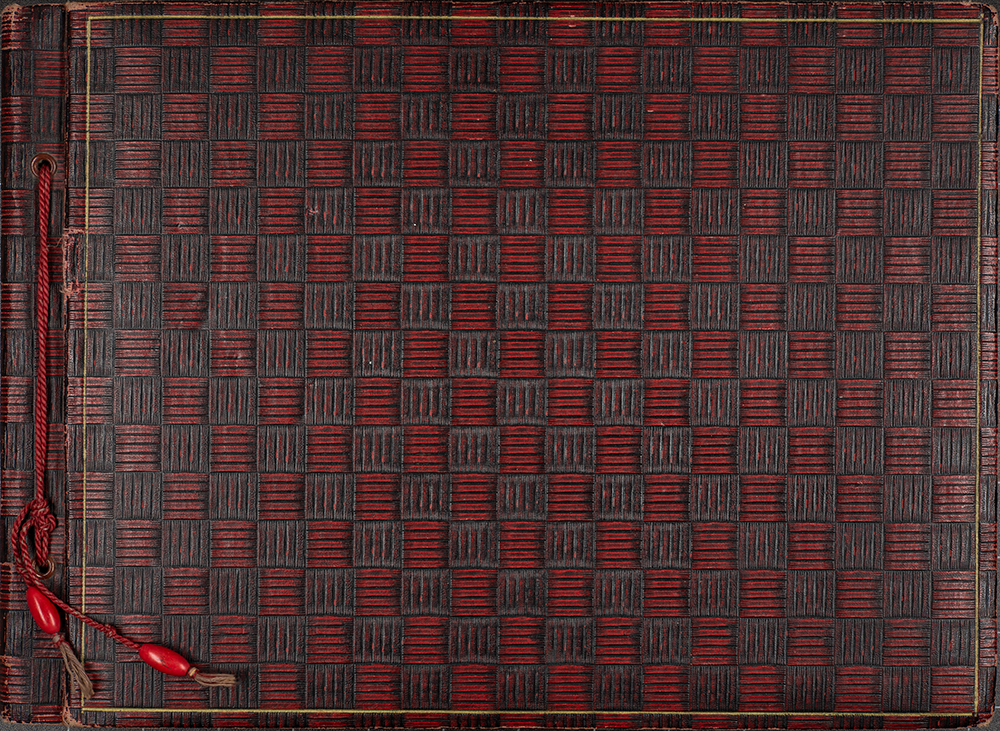
The three albums in the collection form a narrative that is broadly structured by theme but not chronologically coherent. Reflecting the problematic vision of colonial society in Indochina, they readily juxtapose family snapshots and landscapes with scenes of repression following peasant or military revolts, or even staged scenes of young village girls stripped naked.
The chequered-cover album with the forged title ‘Les plages’ begins with seaside photos. These views were taken between 1928 and 1934, with the exception of a photo by Adrien Noblot, estimated to be from 1904. The majority of the views were taken between 1930 and 1932, the main subjects being:
• Beach scenes Cap St-Jacques, Longhaï, Panthiet (1930-1931)
• Delphine and Claudette Noblot’s trips (1930)
• Views of Saïgon, Mytho and Phnom Penh (1930)
• The repression of June 1930, Saïgon
• Pictures of military ceremonies (1930-1935), the inauguration of the monument to Auguste Morère (1934), the King of Siam’s visit to Saïgon (1930)
• Social life and friends : Blachère, Thomachot, Missol, Rinieri, Dasseux, Cadol in Saïgon, unidentified friends from An Khé, the Monnet family (unlocated)
• Studio portraiture (with no date)
• The Thomachot’s trip to the Cham towers near Nhatrang in Annam (not dated)
The second album with a chequered cover, known as the ‘Phnom Penh’ album, begins with photos and postcards of Phnom Penh, dating from around 1928 to 1936. However, it is not possible to date the postcards from the Nadal Studio with any certainty, either in terms of their production or their acquisition. The main subjects of the reports in the ‘Phnom Penh’ album are:
• King Sisowath’s cremation, King Monivong’s coronation and the Monivong Bridge inauguration in Phnom Penh (1928)
• Cochinchina gendarmerie stations
• A trip to Dalat with gendarmes’ families (around 1934-1935)
• Hunting parties
• River patrol squads in Cambodia
• Views of Phnom Penh with Adrien and Delphine Noblot (around 1935-1937)
The third album, known as the ‘Brun’ album, covers a vast chronological period, from 1923 to 1937 but most of the views were taken between 1932 and 1937. Not all the pages of the album have been used, and some photos have not been mounted. They are still inserted between two pages. The Brun album shows:
• Military and civil ceremonies (1936-1937), with the Monivong bridge inauguration in Phnom Penh
• Portraits
• The family house in Vonnas, Ain département (1937 ?)
• The Saïgon Eucharistic congress (1935)
• Caodaism religion
• The Phan Rang typhoon (1932)
It is difficult to reconstruct how these albums were put together: none of the reports is totally exhaustive, duplicates are sometimes pasted into two different albums, and photographs have clearly been extracted from their original report to complete other sets. There is also a paper print of a glass plate (probably a countertype).
The Report "Gendarmerie coloniale – Détachement de Cochinchine Cambodge, section de Saïgon"
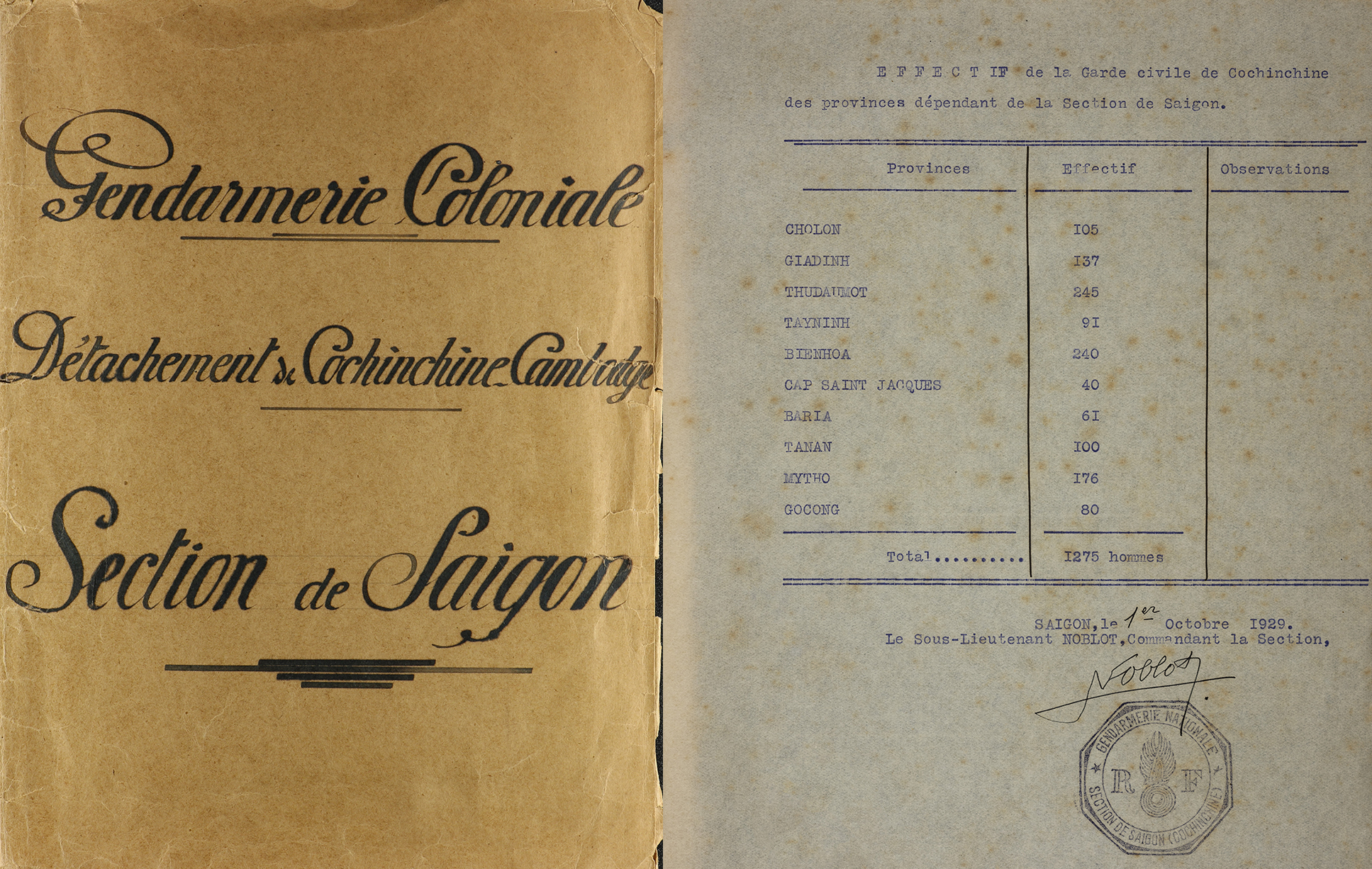
From 1911, the colonial gendarmerie in Indochina was organised by two decrees ( Bulletin annoté des lois et décrets. 1911-1, p. 532 and JORF 21 October 1911) which provided for two detachments of 140 soldiers each under the command of a separate captain, one in Annam-Tonkin with its headquarters in Hanoi, and the other in Cochinchine-Cambodia with its headquarters in Saigon.
Adrien Noblot was promoted to second lieutenant commanding the section in Saigon in 1929. Perhaps it was on the occasion of this appointment that the report was commissioned from him. It is indeed dated and signed 1 October 1929.
This report is the most structured document in the collection, with the most captioned and contextualised photographs. It presents the results of an inspection carried out in gendarmerie posts in the Cochinchine-Cambodia district, the district to which Adrien Noblot was attached. It describes the resources, missions and activities of these various posts. Unless there is an explicit inscription on the photos, they have all been dated to the date the report was submitted, i.e. 1929.
Some photographs intended for the report or initially included in the report have enriched to the pages of certain albums. This dual assignment is indicated in the database by the link "est une partie de” (“is part of”) and "photo en relation” (“related photo”).
Stereoscopic views on glass plates
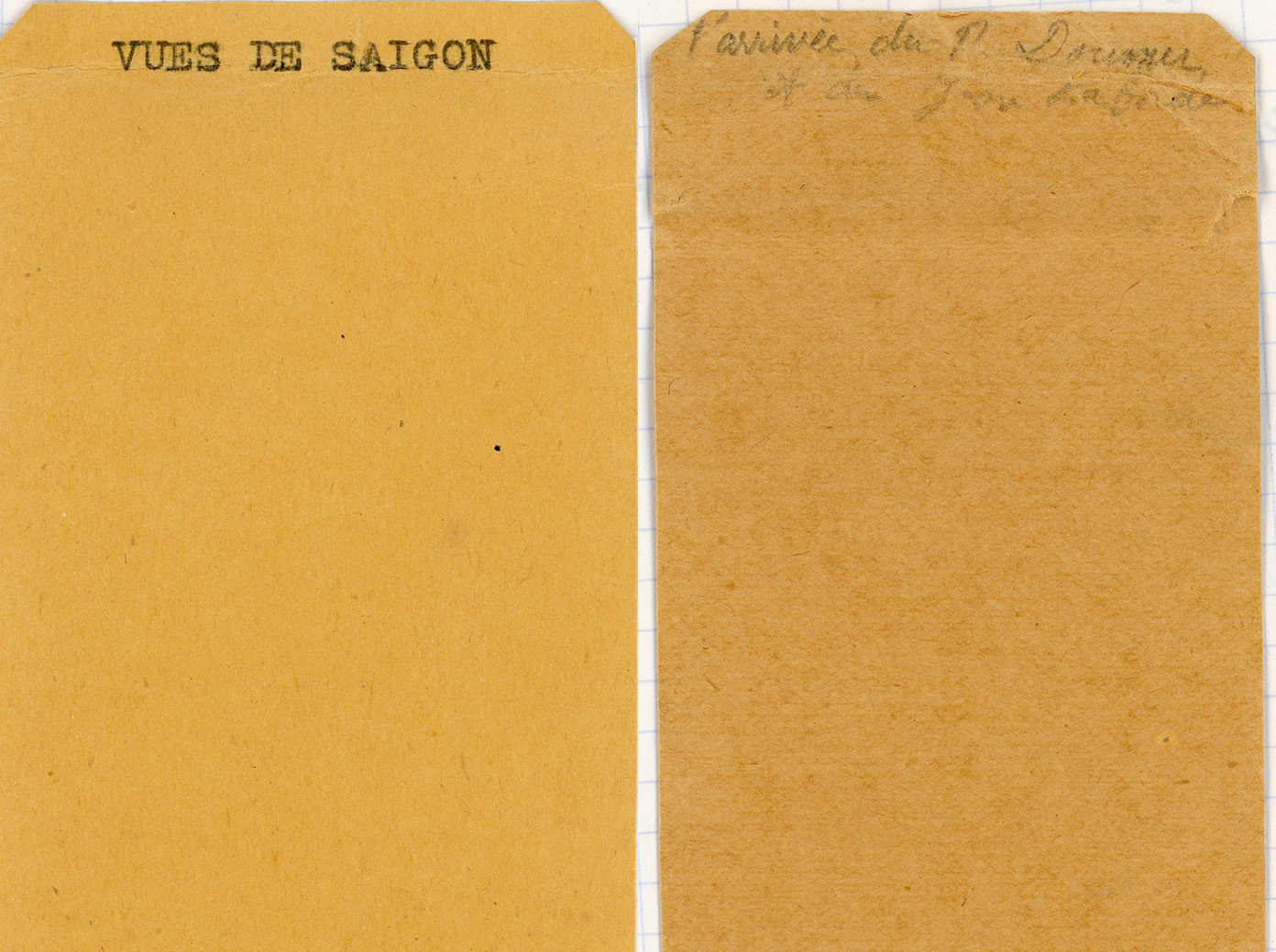
The 448 stereoscopic views on glass plates constitute a heterogeneous collection but the themes represented on the plates are representative of the rest of the collection. However, it is noticeable that the family interior in Saigon, he temples of Angkor, certain tourist sites such as Bokort (Kampot province, Cambodia), Hatien (Hà Tiên, Kiên Giang province, Việt Nam), Oudon (Cambodia), and the Khône Falls (Laos) only appear on the plates.
The identification details for the glass plates are the labels on seven of the ten boxes, and cardboard dividers, inserted between the plates.
Gathering of the Noblot collection
Adrien Noblot (1885-1942)

Adrien Noblot's service record ( "fiche matricule" ) provides information about his military career and the circumstances of his arrival in Indochina in 1904 as a volunteer. The oldest photograph of Adrien Noblot appears to be the first photo on page 21 of Album 1 "Les plages", perhaps taken just before his first departure in 1904.
He married Delphine Dubois (1898-1945) in Vonnas in 1919 (Archives départementales de l'Ain, mariages de l'année 1919 à Vonnas). Their only daughter Claudette (1920-2013) was born in Cantho, Cochinchina (Cần Thơ, province of Cần Thơ, Việt Nam).
In 1929, he took command of the force based in Saigon. From that date onwards, he is regularly mentioned in the colonial Indochinese press until his return to mainland France on 25 April 1939. This posting probably constitutes the starting point of the Noblot collection: documenting their life in Indochina, illustrated by photographs set out in albums or compiled in boxes for glass plates.
Adrien Noblot is the subject of many shots in these albums, but never appears with photographic equipment in his hand. His photographic aptitude is reported by the family narrative constructed by his daughter Claudette. Moreover, there are no negatives in the collection entrusted to us and the only equipment preserved by the family is a wooden stereoscope for viewing the plates. It is therefore impossible to state that the photographs or albums were actually taken by Adrien Noblot.
The photographs of Delphine and Claudette Noblot
Delphine Noblot is the person most frequently depicted in the photographs in the family collection and many photos can be attributed to her, particularly those of her daughter Claudette, many excursions and beach scenes.
On group outings, she sometimes entrusted the camera to her daughter so that she could be present in the photo, as can be seen in the series illustrating an outing to Ba Lua (near Thudaumot, Thủ Dầu Một, Binh Duong province, Việt Nam) with Mr Dasseux and an unidentified couple in May 1930: in the first photograph, we can see the shadow of Delphine Noblot wearing a cloche hat and holding a Rolleiflex-type camera with a fixed mirror viewfinder. Claudette replaces her in the second photograph. The adults have sat down to be at her height.
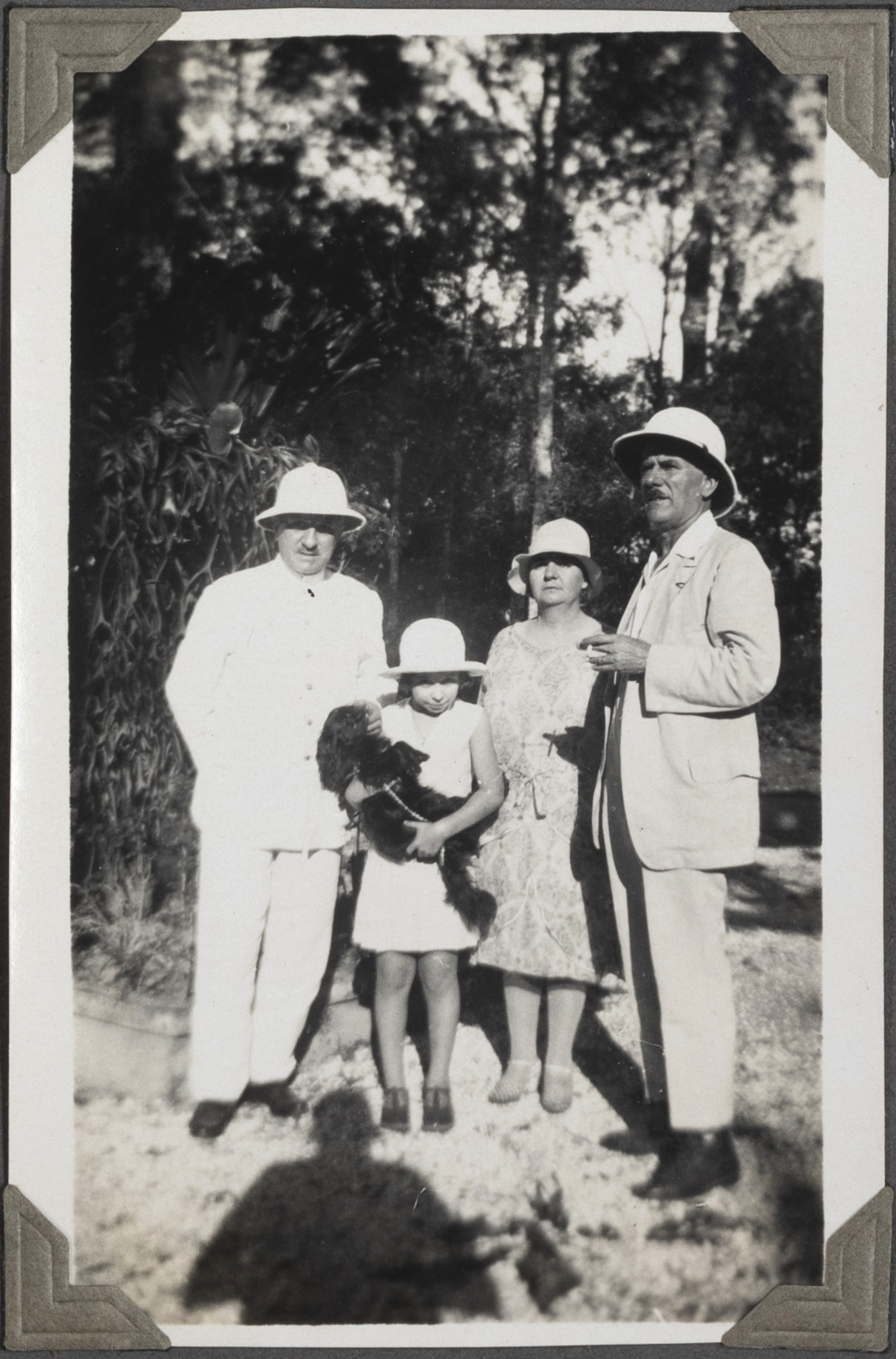
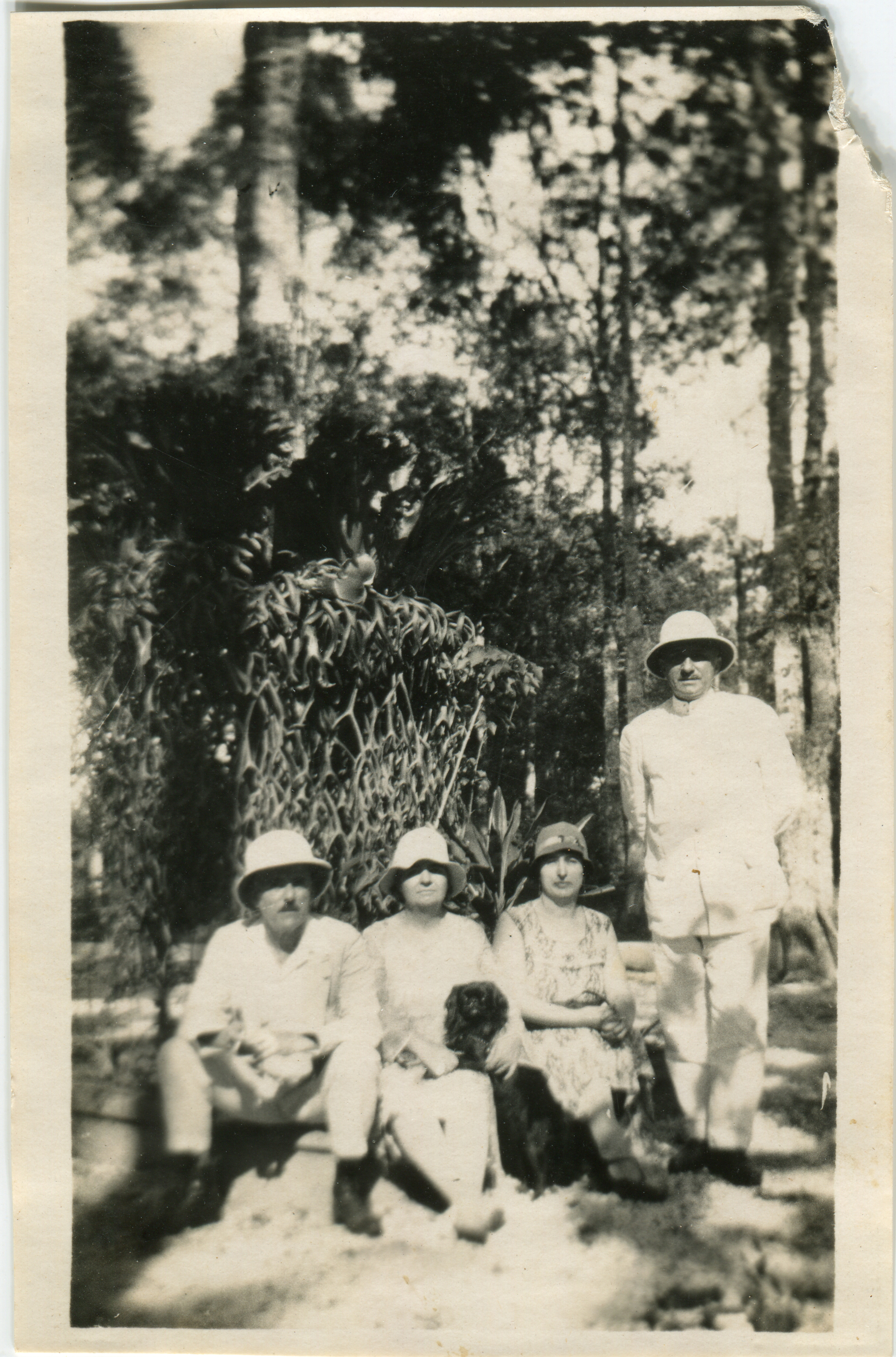
Looking through the albums and trying to match them with an author also raises the question of when they were compiled, as the reports are not always in chronological order. The individuals are identified randomly, and it is not known whether the names are unknown or were forgotten when the captions, which are often incomplete, were written. In addition, a significant number of photographs bought from professional photographers mixed in with the personal photographs suggest that the narrative was compiled by Claudette Noblot after her return to France, perhaps at a late stage.
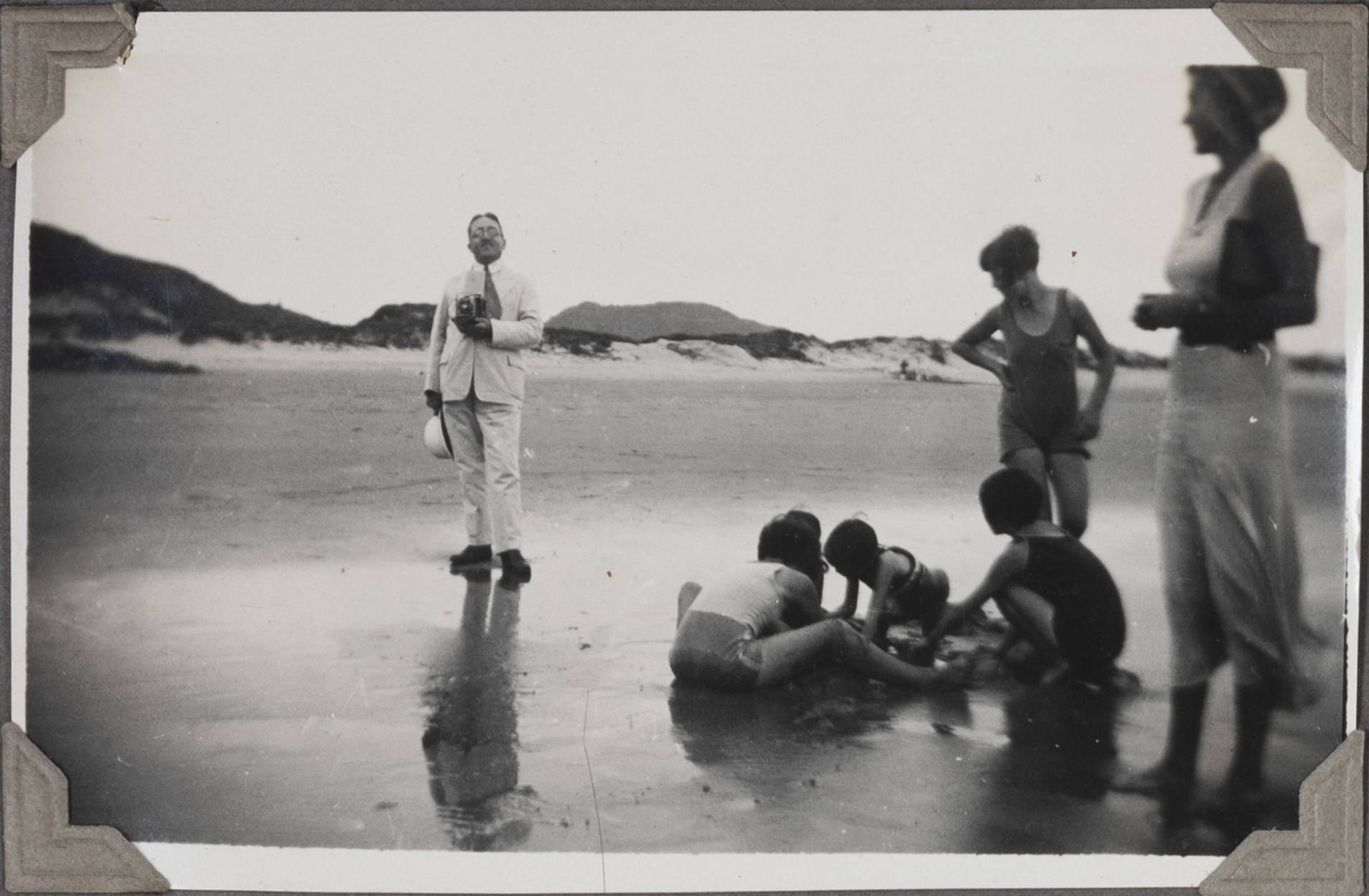
The Blachères
René Blachère, his wife Paule d'Ornano and their daughter Geneviève are key figures in the collection, appearing in photographs from 1929 onwards, both in Indochina and in Vonnas, France. While it is difficult to say anything about Adrien Noblot's photographic practice, three photos do show René Blachère with a camera.
Captain René Blachère (1893-1985) was an officer in the colonial gendarmerie. He joined up in 1911 and pursued a military career that took him to Indochina in 1926, which he left in 1937, like the Noblots. Initially posted to Hanoi, he became commander of the Cochinchina-Cambodia gendarmerie section in 1929. He carried out several missions in Nui-Bara, from where he brought back the body of sergeant Auguste Morère, who had created this gendarmerie post.
The marks of professional photographers

Across the entire collection, there are a total of 36 signatures or stamps from photographers and studios on the paper prints, including that of Fernand Nadal. These marks are stamped to images documenting major events in the colony in series appearing in other collections such as the funeral of King Sisowath and the coronation of his successor Monivong. These series appear to have been commissioned by the administration, which used professional photographers working in the colony. Similarly, the photographs of the colonial administration's personalities (residents, governors) and the King of Cambodia come from professional studios, as indicated by numerous stamps: Photo Nadal Saigon, Royal Photo Phnom Penh, Catinat Photo, Khanh Ky, Royal Photographie, Phnom Penh, studios also used for portraits and family subjects.
A photograph documenting the Eucharistic Congress in Saigon, which was held from 12 to 16 December 1935, made it possible to identify the unknown author of a series published in the missionary organ Echos de nos missions in 1936, Tourist Photo, 48 rue J. Eudel, Saigon.
Attribution of glass plates
While some photos printed on paper and postcards bear the photographers' marks, it is more difficult to attribute the glass plates. The photos of Angkor featuring Paule Blachère were most likely taken by her husband René Blachère, as neither Adrien nor Delphine Noblot appear in any of the Angkor shots. For the same reasons, we can also propose this attribution to René Blachère for the views of Preah Vihear.
At least one series seems to have been taken by a professional photographer, the one on the 1937 Paris World Fair, but it is also very likely that the stereoscopic views of the rice paddies and the interior views of the Royal Palace in Phnom Penh were purchased from professional photographers.
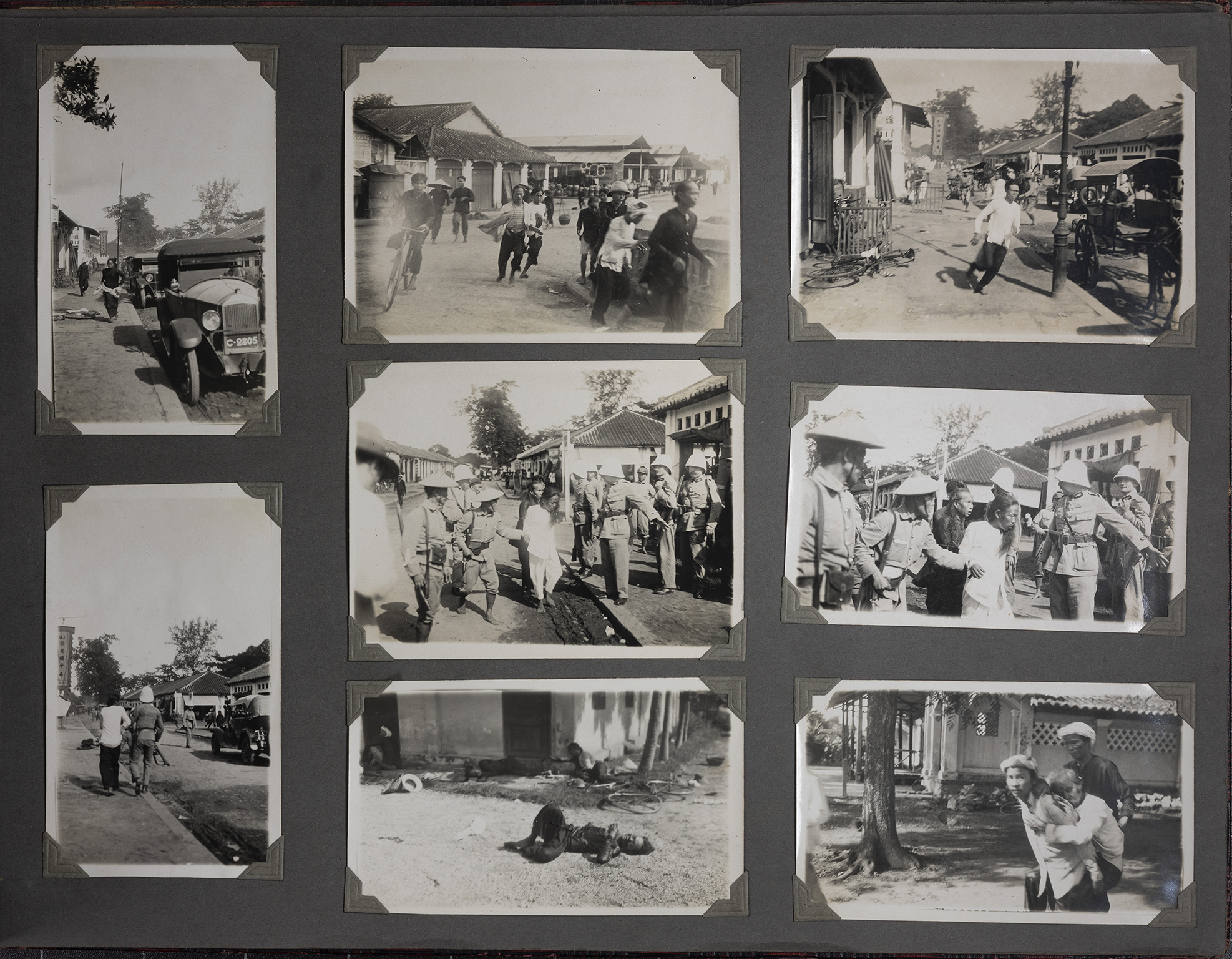
Photographic themes
The Noblot collection presents classic documentation on touristy and picturesque Indochina as seen by the colonial society (colonial and local architecture, ’ ethnographic and social types’, life in the colony with official and private ceremonies), in an Indochina limited to Cochinchina and southern Annam, i.e. the southern half of present-day Vietnam and Cambodia, following the professional career of Adrien Noblot.
Its originality lies more in the presentation of these photographs alongside images of the Noblots' private, family and social life, as well as a presentation of the coercive colonial system as perceived through Adrien Noblot's professional activity.
Indeed, the collection offers important and rarely seen documentation on the workings of the Saigon gendarmerie, including a gendarmerie report. It covers the activities, resources and buildings of the posts of the colonial gendarmerie in the district. Other series in the albums show the awarding of decorations to Adrien Noblot as well as military ceremonies. Finally, a series documents the violent repression of the revolt of the Xô Viêt Nghê Tinh in Saigon in June 1930, whose annotated photographs are inserted in the album ‘Les plages’ among family photos.
It is worth noting that certain social events that did receive photographic coverage do not appear in the collection: the visit of Paul Reynaud to Indochina in 1931, the attempts to break the speed record for a plane flight between Paris and Saigon, and the visit of Astrid and Baudoin of Belgium in 1932. However, on page 29 of album 1, ‘The Beaches’, stuck in the middle of the report on the festivities organised for the visit of the sovereigns of Siam to Saigon (14-16 April 1930), there is a Belgian stamp bearing the image of Queen Astrid of Belgium.
Although the family documentation is the richest, some family events are not documented, such as Claudette's communion ceremony at the cathedral in Saigon. It is also worth noting that there are no photographs of Claudette before the age of 9 (‘Theatre scene: troupe in costume’ album_Noblot_vol-1_26-02 and album_Noblot_vol-1_26-04).
A series whose limits are difficult to define may have been taken before the definitive departure from Indochina in 1937. It shows Delphine and Adrien in Phnom Penh, in Saigon, portraits of them in their car and, above all, the interior of their house in the officers' barracks.







